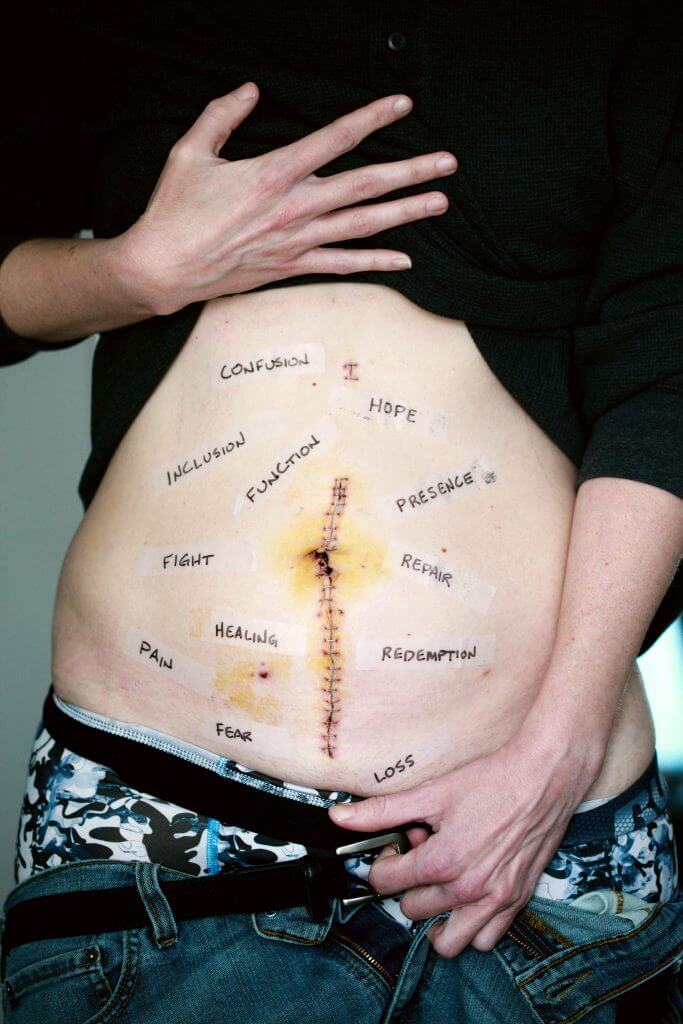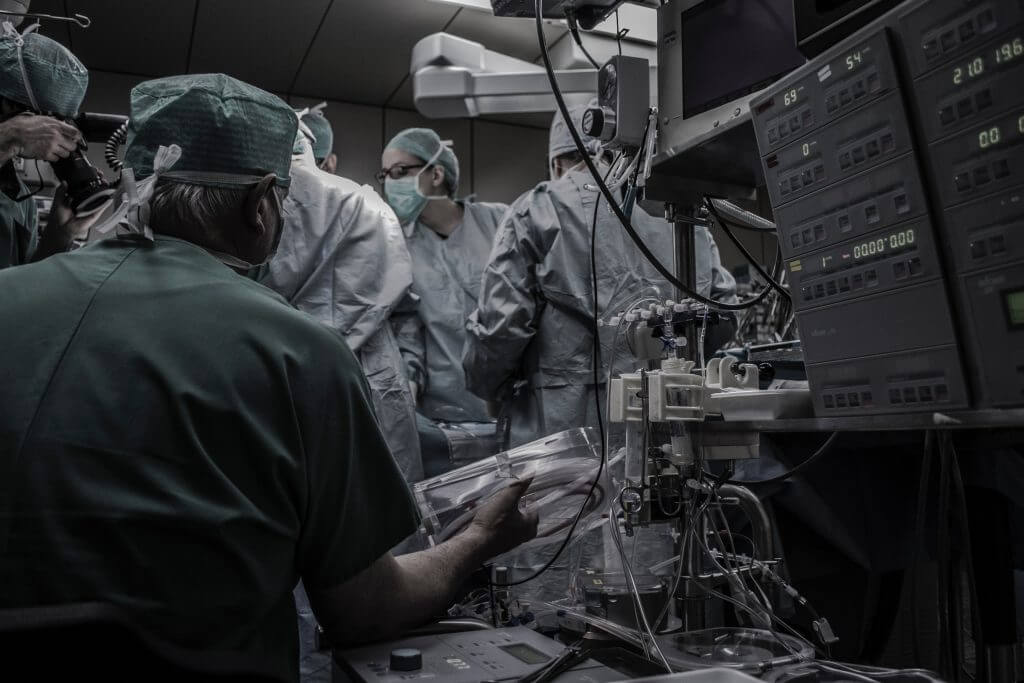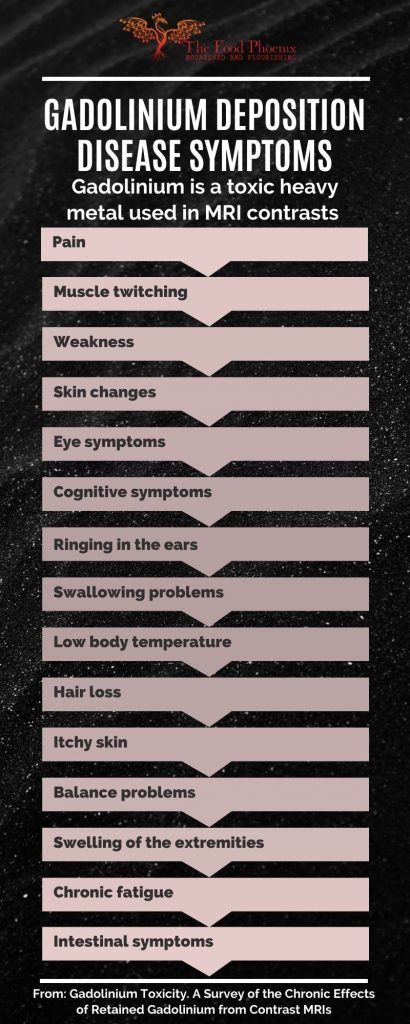Gadolinium deposition disease symptoms can be debilitating, but you don't have to suffer in silence.
Learn how to recognize the signs and take control of your health.

I had a single gadolinium-based contrast MRI. But, boy, was that a mistake.
If you’re reading this post, chances are that you’ve made a similar mistake or you’re considering having an MRI contrast. Read on to discover what symptoms I and countless others developed after being injected with this radiological contrast dye for MRIs.
Wednesday 9th November 2016: That was the day my life changed. That was the day I had a routine screening magnetic resonance angiogram (MRA) using a contrast agent called MultiHance. And it was the same day that my journey with Gadolinium Deposition Disease symptoms began.
I was uninformed, uneducated, and had no idea what I was walking into. I knew that I was having the contrast-enhanced MRA scan done to screen for rare complications of an inherited condition. There was a strong possibility that the MRA would be normal (and it was).
Before arriving at the hospital for the scan, I had no idea I would be injected intravenously with contrast. As a result, I didn’t bother researching MRA contrast agents.
If I had done some digging, what might I have found back in 2016?
Very little. I would have discovered that MRI and MRA scans can use several types of contrast agents. However, all of them use a highly toxic heavy metal called gadolinium.
The only patient group being followed up long-term following gadolinium-based contrast agent (GBCA) use were patients with kidney failure. I would have also found out that GBCAs were indisputably known to cause an awful, chronic, life-threatening condition in renal patients. This condition is called nephrogenic systemic fibrosis (NSF).

But I would have also read some (falsely) reassuring propaganda stating that renal patients differed from all other patients.
Renal patients retain gadolinium because of impaired renal function. But, like all my clients offered MRI contrast, I was reassured that everyone else eliminates the GBCAs within about four days of being injected. Unfortunately, this sort of thinking was very prevalent in 2016, even though several articles disproved this even then. What’s worse is that, to this day, most doctors still believe this.
I have normal kidney function. So, I should have had no reason to worry. I wasn’t going to retain gadolinium. Or was I?
And if you, like me, have healthy kidneys, should you worry about retaining gadolinium contrast, too? Great question. You can just read on to find out.
What else might I have discovered about gadolinium deposition disease (GDD) if I had dug a little deeper?
Some rather unsettling reports from an awesome patient support group called the Lighthouse Project. The Lighthouse Project had collected stories, in the form of a survey, from people who complained of chronic problems after receiving one or more GBCA-enhanced MRI scans.
The Lighthouse Project have also amassed a database of urine results which go back several years. They prove that many people continue to eliminate gadolinium in their urine for months and even years. The fascinating thing about this data? NONE of these people had kidney problems when they had their GBCAs. In other words, gadolinium deposition is typical following an MRI scan with contrast.
What symptoms of gadolinium deposition disease did these people complain about?
Here is a list of the symptoms documented by the Lighthouse Project:
- Pain
- Twitching
- Weakness
- Skin changes
- Eye symptoms
- Cognitive symptoms
- Ringing in the ears
- Swallowing problems
- Low body temperature
- Hair loss
- Itchy skin
- Balance problems
- Swelling of the extremities
- Chronic Fatigue
Many of them were suffering from a constellation of symptoms, but they tended to fall into a few main categories:
- All of them reported chronic pain. Pain was the number 1 priority for people who had multiple GBCAs
- Almost all reported chronic muscle symptoms, like twitching and weakness
- Most said some persistent skin changes
- Many reported chronic eye symptoms
- A lot reported chronic cognitive problems
- Most reported new onset of ENT problems, like ringing in the ears, swallowing difficulties and voice problems
Lots reported other problems, including low body temperature, hair loss, itchy skin, balance problems, swelling of the extremities, and chronic fatigue.
Could they be suffering from Gadolinium Deposition Disease symptoms?
I’ve mentioned that gadolinium is a heavy metal. Like other heavy metals, it damages your metabolism by harming your mitochondria. Recent studies confirm that people suffering from symptoms following exposure to MRI contrast agents have deranged mitochondrial function. I’ve described how gadolinium and other toxins cause symptoms by poisoning your mitochondria and cells in another post, so I won’t repeat it here. But if you’d like to learn more about how these toxins derail your metabolism, check out this post.
A study published in early 2022 revealed that a small group of people attending a clinic for IV chelation therapy with DTPA following GBCA injection for MRI scans had abnormal mitochondrial function. The authors measured the following differences in their mitochondrial testing:
- reduced mitochondrial biogenesis with severely lowered levels of PGC1alpha and NRF2,
- abnormal metabolic regulation and cellular survival with significantly reduced levels of humanin,
- problems with energy generation with reduced levels of nicotinamide mononucleotide adenyl transferase 2 (NMNAT2) but increased levels of Sterile Alpha and TIR motif-containing protein 1 (SARM-1) and
- abnormal dynamic and maintenance functions with far greater myosin 6 (MYO6) levels but reduced levels of leucine zipper EF-hand containing transmembrane 1 protein (LETM1).
The study authors suggested that this mitochondrial dysfunction could underlie the neuropathic pain, new-onset frequent headaches, “brain fog,” and muscle fatigue experienced by patients with gadolinium deposition disease (GDD).
GDD is the term coined by Dr Richard Semelka for many of the most commonly experienced long-term symptoms. Gadolinium Storage Condition (GSC) is what he has called the retention of gadolinium in people who do not (at present) complain of any characteristic symptoms.
A cutting-edge new theory about how MRI contrasts can cause Gad deposition disease (GDD)
As I work with more and more patients and observe my own recovery from the symptoms of gadolinium deposition disease, I’ve come to believe that gadolinium contrast’s toxicity is magnified by the way it impairs your metabolism. A broken metabolism makes many basic cellular and mitochondrial functions less efficient. As a result, you can start to create more waste products as a byproduct of everyday metabolic tasks.
Research shows that we don’t have infinite resources of nutrients and antioxidants after all. Everyone has a threshold, which, when exceeded, causes your cells to start creating more toxic byproducts. This happens because you have finite amounts of nutrients within your cells, like vitamin B6 and thiamine (vitamin B1). So many simultaneous reactions rely on these nutrients that if you pile on more work in the form of additional toxins to eliminate, you need to steal the nutrients that regulate these processes from reactions where they’re playing essential roles.
You drop the ball, metaphorically speaking.
The net effect is that toxins can deplete your essential nutrients or block how they work, creating one or more functional nutrient deficiencies.
In turn, the nutrient deficiencies cause your metabolism to malfunction to some degree. And this can cause your cells to create more toxic waste products.
The toxic waste product I believe is responsible for causing a lot of the carnage in gadolinium deposition disease is a tiny yet toxic organic acid called oxalates. Oxalates can and will accumulate inside your cells and within your body over time unless you take steps to support your body in eliminating them. And oxalates can also bind with positively charged molecules like minerals and heavy metals to create crystals that can act as stores for oxalates, heavy metals, and whatever other compounds get sucked in there.
You could think of these stores as deposits. And gadolinium is precisely the type of positively charged heavy metal that will likely end up being deposited inside these oxalate crystals. So my theory is that for many people, the toxic effects of the gadolinium contrast become magnified by driving your increased production of other toxins created as waste products. One of those toxins, oxalates, can even accumulate inside your cells. Incidentally, in private communications, Professor Brent Wagner has told me that he and his team have demonstrated that in the test tube, oxalates can transmetallate gadolinium and knock it right out of the contrast in some of their experiments. So oxalates may also free gadolinium from the contrasts. Free gadolinium is a hell of a lot more toxic than gadolinium bound in contrast.
What symptoms of gadolinium toxicity did I develop after my one and only GBCA?
(You can be sure that there is nothing on this planet that would convince me to have another one)
I was fine when I was in the scanner and for a few hours afterwards. I was fine until I got home. It wasn’t for several hours that I developed my first symptom: a headache. And it was a doozy.
It was pounding. It was severe. It didn’t go away.
That headache was like my shadow; day and night, it hammered at me for months, unabating. It chipped away at me constantly. Boom, boom, boom. It hurt to laugh, cry, and even move my head. But the headache was just the start of my problems.

That night I barely slept.
I’ve had insomnia before, and I’ve had it for years. But it had been improving. This inability to sleep felt different from before. It felt like every nerve was switched on. I felt electrified. No matter what I did or how hard I tried, my poor little brain couldn’t switch off.
If you’ve ever had insomnia, you’ll know the frustration. You struggle to relax. So you attempt everything you can to wind down; count backwards in 7s from 1000; try to read; listen to music; meditate; breathe. Then, endeavouring to get some rest, you go to bed earlier. But instead of getting more sleep, you spend more time staring at the ceiling.
Next, you buy blue-light-blocking glasses. Again, lots of people swear by them. But it turns out they don’t do anything to help you sleep. After that, you get your mitts on some CBD oil. Still nothing. Slowly driven crazy by getting a mere three hours of sleep a night, you listen to self-hypnosis CDs. Finally, you turn off the wifi.
I’d cut out coffee a couple of years earlier, so it was well out of my system. I rarely drink alcohol, but that insomnia might have driven me to drink. But I already knew that alcohol knocks my sleep off.

Nothing worked much for at least a year! I could get to sleep for about 3 hours but then ping awake again. I’d toss and turn, sometimes for hours. Then, if I could get back over to sleep again, it was for 30-45 minutes at a time, and that was it. Yes, I was exhausted. Yes, I was irritable.
But my symptoms didn’t stop there either. It was a relentless march into decrepitude. Over the following weeks, months, and even years, old symptoms flared up and brand new things I’d never suffered from before appeared. I ended up with the same, or very similar, symptoms as the people in the Lighthouse Project Survey, and then some. I’ll write about them in a future blog post.
How did I feel about being poisoned by gadolinium?
Much like anyone who suffers from Gadolinium Deposition Disease symptoms, I was DEVASTATED.
Although this was how I felt after gadolinium deposition disease symptoms stole my vitality, these are the same feelings I hear echoed by my gadolinium-injured clients:
- disbelief that this could have happened,
- feeling lost because my doctors hadn’t a clue what was going on with me and never offered me any treatment for gadolinium deposition disease,
- a sense of betrayal,
- guilt that I’d let this happen,
- fury and resentment,
- disappointment,
- mental and physical exhaustion,
- deep sadness,
- isolation because it was so hard to find someone who understood what I was going through, and the physical challenges made it challenging to meet up with friends,
- hopelessness,
- fear for my life and
- fear for my health.
Picturing a future of debilitation and disability, I imagined that my life would be cut short by cancer, heart disease, a stroke, or Alzheimer’s.
This desolation is what grief looks like. The grieving process you experience when you lose your health is truly underrated. And even though the symptoms of gadolinium deposition disease can be life-altering, on the surface, you are still much like the same person to everyone else. The only clue that something isn’t right from a physical perspective could be your weight changing and the appearance of fatigue on your face. You may even try to hide expressions of pain from your loved ones to protect them.
This grieving process is so profound yet often overlooked that I wrote some posts about it to help you, your loved ones, and your doctor understand what’s going on in your head. You can read the first one here. But I’ve also written a post about the mental torment caused by gadolinium deposition disease in this post.
I was in pain. Joint instability, fatigue, and soreness reduced my mobility, and I was starting to see joint damage permanently restricting my movements for the first time in my life. Fortunately, although it took a couple of years, that joint damage is now in remission, and my mobility is back to my pre-gadolinium days.
So, I started calling this illness Gadolinium-Induced Petrification Syndrome (GIPSy). The petrification was particularly poignant when I looked at people with NSF and some of the people in the gadolinium support groups. Their tissues slowly hardening as they turn into living, tortured statues.
When we are cursed with this horrible condition, fear permeates our consciousness.
What did I do?
Much like you, I joined gadolinium support groups and befriended many similarly afflicted people there. Over the past couple of years, I have watched the numbers in these groups swell into the thousands. All of us crying out for help. We’re all in pain. We’re terrified. So many of us exist from day to day, but we’re not living. Not really.
Doctors prescribe us pain medications, antidepressants, and medications to calm our symptoms.
Many of us have had repeated gadolinium contrast scans to try to find the underlying causes of our new symptoms. But, Of course, nothing shows up. So lots of us are subjected to many more tests and preliminary diagnoses because nobody considers gadolinium toxicity. Instead, our doctors tell us we have diseases like:
- Amyotrophic Lateral Sclerosis (ALS, or Lou Gehrig’s disease),
- Fibromyalgia,
- Psychiatric illness,
- Benign Fasciculation Syndrome,
- Autoimmunity, and more.

Gadolinium Deposition Disease is a desperately isolating condition
Most of us have to put the pieces together on our own. We have to raise the possibility of gadolinium toxicity with our doctors, and all too often, they dismiss the onset of new symptoms as coincidental, imaginary, or due to some other illness.
Not only do our doctors dismiss us, but many times our family members do too. Sometimes, this is because gadolinium seems to ravage all of our organs. As a result, we present with constellations of symptoms in multiple tissues simultaneously. It’s inconceivable to them, but not to us, that one toxic compound could cause so many symptoms.
We also notice that our symptoms evolve over weeks, months or years. Some symptoms improve or resolve, only to be replaced by several more.
Some would have you believe we are only allowed only one symptom per toxin. For these people, it is also inconceivable that the most potent calcium channel blocker known to man, one that causes inflammation, mitochondrial damage, fibrosis, tissue calcification, and cellular damage, could result in hardening of arteries or increase the likelihood of strokes, heart attacks, Alzheimer’s, Parkinson’s, cancer, or any other chronic illness.
What’s it like to feel unheard and not believed?
Not being believed by the people around us makes us feel isolated. Where do you find support if people won’t admit that you might have been poisoned? When you are already exhausted and down, you don’t have the energy to fight your corner over this. You barely have the energy to explain how awful you feel.
This creates an immense barrier to receiving a gadolinium deposition disease diagnosis. Over the last few years, there’s some evidence that more mainstream doctors are starting to recognise that gadolinium is toxic. Of course, any sane doctor already recognises that heavy metals are poisonous, and gadolinium is a heavy metal. So, you’d imagine it would be a simple process to get your doctor to wake up and diagnose you with heavy metal poisoning at the very least. But you should be so lucky.
Unless you’re one of the lucky few with an enlightened doctor who hasn’t been dazzled by the bright lights of Big pHARMa, it may be a struggle to find one to diagnose you with gadolinium deposition disease. Even though it’s not your job to raise awareness of GDD, you may need to educate your doctor. You may even need to get them to check your urine for gadolinium for them to believe that you’re still excreting it more than 48 hours after the injection.
And if you eventually convince your doctor that the contrast is causing health issues, what then? Will they know what to do to make you feel better? I’m afraid that getting a diagnosis and recognition is only one hurdle on your path to recovery. Because very few clinicians know how to treat patients who have been poisoned by gadolinium or any other drug. There are no medications that will ease your suffering to any proper degree. Intravenous chelation works well for some. But equally, far too many people rue the day they ever started with chelation.
Thankfully, there’s another way to feel better. One that doesn’t involve medications or even getting your doctor to agree to a gadolinium deposition disease diagnosis. And that is to use diet, supplements, lifestyle changes, and other natural means to support your body to eliminate toxins and improve your metabolism.
When I started my career as a doctor, I wouldn’t have believed such deceptively simple-sounding measures could ever be so powerful. Yet, here I am, extolling the virtues of nutrition and supplements. But I only do it because they’ve worked for me and many others. If you’re intrigued and would like to learn more about how I and many others have been recovering from this debilitating illness, you can book a no-obligation FREE clarity call with me here.
When will good quality research be done on Gadolinium Deposition Disease (GDD)?
Few researchers know that gadolinium causes a host of cellular problems that can affect any cell in the body. The rest are understandably reluctant to put their careers on the line or even develop a testable theory about the mischief that these contrast agents have the potential to cause. In addition, conflicts of interest obstruct research avenues. There may be some hope in the form of a drug called HOPO. But HOPO is still in the early stages of testing and likely won’t be available for several years.
We have lost allies and friends to Gadolinium Deposition Disease along the way
Is gadolinium deposition disease fatal? Some of us have died on this journey. Some of us have had heart attacks and survived them. Some of us have been diagnosed with cancers, particularly multiple myeloma, a cancer shown to be made so much more aggressive in the lab when exposed to gadolinium contrast. This multiple myeloma research is already a decade old, and yet, to this day, we’re still waiting for further research to be done on these incredibly worrying findings.
I will mention one particular gadolinium toxicity warrior. Marcie Shea Jacobs was a lioness. She set up one of the first gadolinium toxicity support groups on FaceBook. Marcie was there for so many of us when we tried to find our way. Kind, unflinching and determined, she predicted her own death. After about a dozen contrast-enhanced MRI scans, Marcie knew she had severe gadolinium deposition. She knew her tissues were calcifying and fibrosed. All of us who knew her miss her dearly. She was one of our greatest advocates.
When I started experiencing symptoms from gadolinium deposition, I searched for success stories and protocols in the support groups. I wanted to find someone who had discovered the solution to the gadolinium toxicity problem. And just like everyone else, I wanted the unicorn cure.
I was to be disappointed.
People were trying different things. A handful reported some improvements in their symptoms, but they were few and far between. Some people had access to iv chelation therapy (gadolinium is removed very inefficiently by standard oral chelating agents).
Mixed reports have come back from people undergoing iv chelation. Some have found their symptoms improve after many treatments. However, some find this relief is temporary. Some have a flare-up of symptoms after IV chelation but don’t notice any subsequent improvement, and the flare-ups may make their situation even worse than before. Others seem to see no difference in one way or another.
This was all academic to me because I had no access to IV chelation therapy where I live and no money to travel elsewhere for it.
How a Gadolinium Deposition Disease survivor gave me hope
There was one major success story, and that was Gena Norris. Gena has spoken in interviews about her experiences after receiving multiple doses of a gadolinium contrast agent. She is always gracious, caring, and compassionate. She talks about how she felt that she was dying and needed immediate help to save her life. Gena is the wife of Chuck Norris. Together they travelled the globe searching for a cure. They used iv chelation, as well as many other therapies and treatments. Gena and Chuck talk about spending $2 million over a couple of years on therapies. She was able to eliminate all gadolinium from her urine, and she has her life back. But she and Chuck know that the treatments and expertise she received are out of the reach of most of us.
Nevertheless, THIS gave me hope that I could heal.
I became a gadolinium toxicity ninja. I read as much as I could about “free” gadolinium, contrast agents, heavy metal toxicity, general toxicity, mitochondria, wound healing, inflammation, oxalate dumping, and lots more.
I tried various protocols. Some made my symptoms flare up. Some helped.
I treated my overgrowth of gut microbes on my own. This provided a lot of relief for many symptoms, not limited to only digestive ease.
But in the end I used the knowledge that I had gained from my nutrition and lifestyle coaching, functional medicine conferences, and lots of information I had picked up from ancestral health interviews, talks and presentations.

One pivotal conference that I attended was on the Bredesen Protocol to reverse Alzheimer’s
At first glance, Alzheimer’s research may seem irrelevant to gadolinium toxicity. However, Dr Bredesen discovered that multiple insults to the brain cause Alzheimer’s. And that many of these cause metabolic damage, inflammation, and cellular damage.
Dale Bredesen discovered that heavy metals and other toxins are significant causes.
He developed a protocol that involved testing for many different underlying causes and then prescribing individualised management strategies based on these results.
Dr Bredesen discovered that the current opinion held by most doctors that Alzheimer’s is a progressive condition is often wrong. Even though Alzheimer’s barely responds to medications, he could often help patients reverse it.
How did Dr Bredesen manage where drug companies had failed? He:
- Prescribed real food, paleo, ketogenic diet alongside lifestyle changes
- Added supplements
- Treated stealth infections
- Reduced inflammation
- Remediated and eliminated heavy metals, moulds and other toxins
- Optimised hormones, nutrients, and trophic factors, and
- Looked for the actual root causes and addressed those.
Dr Bredesen has also written an excellent book on his protocol, titled “The End Of Alzheimer’s”. Reading this gave me some helpful information on herbs and mitochondrial support supplements.
Before I was sick, I was a consultant paediatrician.
While my conventional medical training didn’t equip me to deal with heavy metal toxicity, I did have to attend advanced paediatric or neonatal life support courses regularly. I reflected on how these clearly instruct us that the most effective life-saving treatments are natural. So I spent lots of time reflecting on how things like oxygen, hydration, basic electrolyte balance, sugar, hormones and simple nutrients worked at the cellular level to keep us from dying.
What could a career in conventional paediatrics teach me about how to approach sick people?
Did you know that:
- A wealth of information shows that people in intensive care units often have scurvy, severe vitamin D deficiencies, selenium deficiencies, and other nutrient deficiencies?
- An intensive care unit in Norfolk has almost eliminated sepsis deaths by giving patients high-dose vitamin C, vitamin B1 and steroids (the Marik Protocol)?
- The primary antidote to paracetamol (acetaminophen) poisoning is an amino acid called n-acetyl cysteine, which supports liver detoxification?
- Giving alcoholics and other patient groups high doses of B vitamins and vitamin C can prevent permanent brain damage?
- Before Big Pharma developed antiepileptic drugs, the initial treatment for childhood epilepsy was a very low carbohydrate diet called a ketogenic diet? Or that the ketogenic diet was just as successful as the drugs that replaced it?
- A whole-food, ketogenic diet is the most effective way to reverse type 2 diabetes, getting people off most of their medications?
- Researchers are studying the ketogenic diet as a part of cancer treatment?
The more I thought about it, the more I realised that in conventional medicine, we had been so star-struck by pharmaceutical companies and their promises to treat symptoms that we had forgotten our basic biochemistry and physiology. And in doing so, we shut the door on the possibility that these and other naturally occurring compounds could effectively improve outcomes in chronic and acute conditions.
A large part of the problem is that the pharmaceutical industry excels at writing marketing aimed at doctors but tarts it up and presents it as medical research. They strive to get doctors to prescribe their medications unquestioningly and seed just enough doubt that the medication, even though it causes side effects in patients, never causes side effects in THEIR patients. I’ve written an article about the underhand practices that Big pHARMa employs in pulling the wool over everyone’s eyes here.
The flip side is that conventionally trained doctors are slow to pick up on side effects caused by medications they’ve prescribed and don’t tend to consider how drugs affect people at a cellular level. I’ve written a bit about how medications and other toxins can cause toxicity symptoms in this article.

I used my medical training in critical appraisal to pinpoint and research foods and supplements that could help support me at a cellular and subcellular level.
So I sought out supplements and foods that could:
- provide neuroprotection,
- boost my metabolism,
- boost elimination pathways,
- support calcium metabolism,
- combat inflammation, and
- support connective tissues.
I researched how BELRAD approached radioactive toxicity in Ukrainian children following Chornobyl and how heavy metal toxicity from Fukushima was managed. In addition, I studied the products scientists were investigating for the remediation of environmental heavy metal pollution, with a particular focus on water.
I collaborated with many other gadolinium sufferers, took notes, and shared ideas throughout all of this. People in the gadolinium support groups had a lot to say, and I listened to what was and wasn’t working for them. I tried to provide support and suggestions where I could.
As a result, I created the first all-natural protocol targeted specifically at gadolinium deposition disease.
How successful was I?
I have actually done pretty well. I have managed to control most of my symptoms most of the time. Not only did I get back into exercise, but I built my physical strength to the point where I was stronger than ever. I am not cured. When I come off some of my supplements, it isn’t long before the symptoms start to creep back. I have to be extremely careful about what I eat and even more cautious about what I don’t eat. I can’t burn the candle at both ends. But even my injury healing has sped up from before when it took months or years to recover from minor injuries sustained during training, gardening, or accidents. Every day, I have to focus on self-care. There are no days off. Sometimes, it feels like a part-time job. It can be pretty all-consuming. If you’d like to add more self-care into your life (and I recommend that you take some time to look after yourself regularly), I’ve created a FREE resource you can access here.

But I have a good quality of life again now. My connective tissues are holding my skeleton together much, much better. Thankfully, I am not getting injured as often as before, either. I feel calm and optimistic. My gut health feels normal most of the time. Although it’s up and down, my sleep is improving. I have more energy now than I have had for years, and cognitively, I feel sharper. Most of the time, I feel normal. If I think about it, compared with many other women my age, I may even feel healthier.
Yep. Life is pretty good right now. But I never take it for granted. So you can prize my supplements from my cold, dead fingers.
I’ve been trying to influence and educate others about Gadolinium Deposition Disease as well
I contacted MPs, other politicians, and the European Medical Authority about my concerns and the abysmal state of research on gadolinium. Shortly after this, the EMA withdrew the contrast that I had received and acknowledged that there was a paucity of evidence surrounding the safety of gadolinium contrast agents.
But they fell short of recognising that people out there have normal kidneys yet are suffering from gadolinium toxicity or gadolinium deposition disease. They stated that their actions in withdrawing linear contrast agents were precautionary, but there is no evidence that gadolinium retention causes harm. Unless you have renal failure, in which case it might kill you.
Which is an interesting way of saying that there is a very alarming lack of good quality research on the long term effects of gadolinium retention. Unfortunately, our pleas for help are falling on hearing-impaired ears.
The Daily Mail, Sky News and the Quax podcast have interviewed me about gadolinium contrasts. A few years ago, I wrote a book about MRI contrasts. I am trying to get our story out there. I know that I said I would tell you my story at the top of this page. But Gadolinium-Induced Petrification Syndrome is bigger than me. This is OUR story, and it’s just beginning…
If you need support after a gadolinium contrast, you can contact me here for a free coaching session. I’d love to chat.


